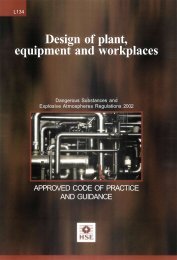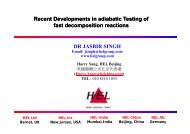Designing and operating safe chemical reaction processes HSG143
Designing and operating safe chemical reaction processes HSG143
Designing and operating safe chemical reaction processes HSG143
Create successful ePaper yourself
Turn your PDF publications into a flip-book with our unique Google optimized e-Paper software.
Health <strong>and</strong> SafetyExecutivea relief vent was installed.163 Appendix 4 contains further advice <strong>and</strong> guidance on the design of emergencyrelief systems. 36,37,38,39Crash cooling164 In some cases it may be possible to bring a runaway <strong>reaction</strong> back undercontrol, particularly in its early stages, by using additional cooling. The usual meansof achieving this are to:(a) bring a reflux condenser on-line;(b) use a refrigerant in the reactor cooling coils or jacket; or(c) pump the reactor contents through an external heat exchanger.In all these cases you will need to assess the reliability <strong>and</strong> integrity of the system.Reaction inhibition165 It is possible to suppress some <strong>reaction</strong>s by adding a <strong>chemical</strong> inhibitor tointerrupt the <strong>reaction</strong> mechanism; eg by free-radical scavenger injection or bypoisoning a catalyst.166 You need to carefully design such systems. In the worst case scenario canyou add the inhibitor <strong>and</strong> distribute it quickly enough? Can it be mixed into the<strong>reaction</strong> mass adequately? The worst case scenario may occur as a result ofagitator failure. In such a case it may be unlikely that the injection of inhibitor wouldbe successful. If the <strong>reaction</strong> mass becomes more viscous during a runaway,which is common for many polymerisation <strong>reaction</strong>s, again it is unlikely thatinhibition will work adequately.Drown-out, quenching or dumping167 These could be considered as special cases of crash cooling. The objectiveis to slow down the <strong>reaction</strong> by mixing a large quantity of cold liquid. This provideseither a sufficient heat sink to remove the heat of <strong>reaction</strong>, or reduces the rate of<strong>reaction</strong> by lowering the temperature or by diluting the reactant concentrations.168 The liquid used is usually water, unless it would react with the <strong>reaction</strong> mass.Even if this does happen, it may be possible simply to add sufficient water to coolthe exothermic <strong>reaction</strong> with the water too.169 If there is sufficient space within the reactor you can consider introducing thequench fluid directly into the reactor from a st<strong>and</strong>by tank. This will need to be keptpressurised. Alternatively, you can simply dump the contents of the reactor into aseparate containment vessel containing the quench fluid.170 In all cases the measure needs to happen sufficiently quickly to avoidoverpressurising the reactor.Secondary containment171 In certain circumstances, particularly when h<strong>and</strong>ling highly energeticsubstances, secondary containment may be considered. This may be necessarywhen venting of a reactor is inadequate. The blast may be diverted to a <strong>safe</strong> placeby blast walls or mounds. This, however, is an expensive option. It also requiresremote operation of the plant which is located away from any occupied areas. Thismethod of protection is therefore rarely used in the <strong>chemical</strong> industry.<strong>Designing</strong> <strong>and</strong> <strong>operating</strong> <strong>safe</strong> <strong>chemical</strong> <strong>reaction</strong> <strong>processes</strong> Page 32 of 64










